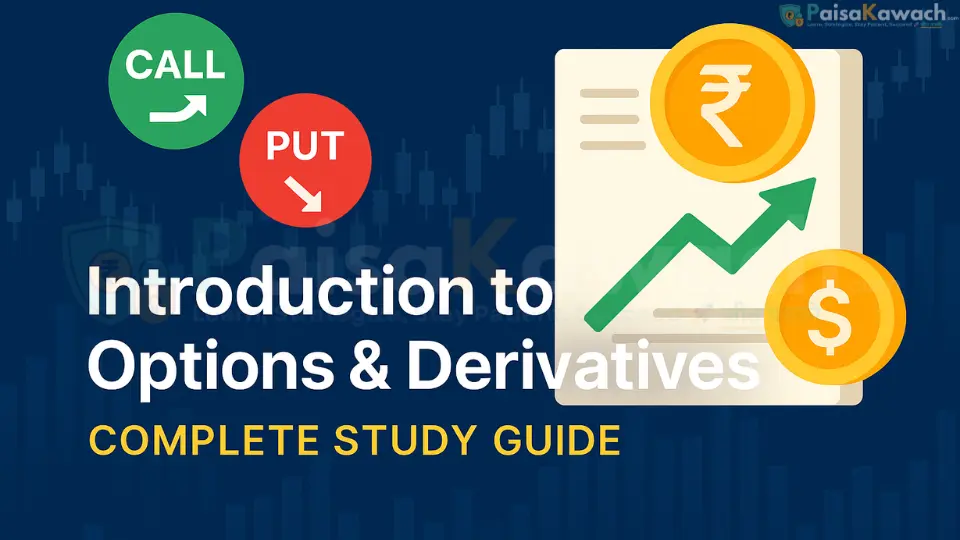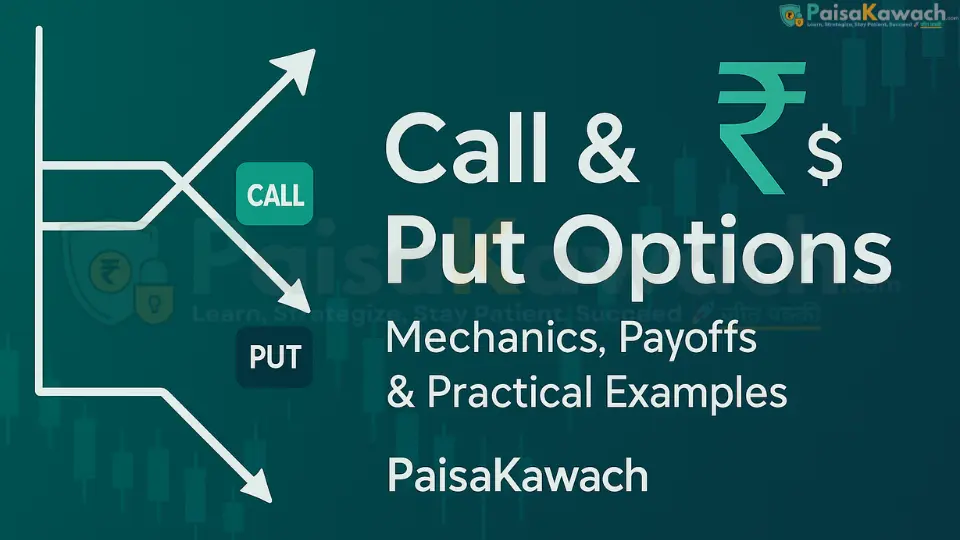Introduction to Options & Derivatives

A complete study guide on options and derivatives. Learn definitions, types, examples, risks, and global usage with simple explanations for beginners.
Derivatives constitute the cornerstone of modern global finance, serving as versatile instruments that drive market liquidity, enable price discovery, and facilitate sophisticated risk management. While their complexity can be daunting for beginners, this comprehensive guide systematically deconstructs their mechanics, purposes, and practical applications. We will demystify what derivatives are, elucidate why they are indispensable, and provide an in-depth exploration of options trading, complete with tangible, real-world examples denominated in Indian Rupees (₹) alongside approximate US Dollar (USD) equivalents in brackets to ensure clarity and global relevance.
1. What Are Derivatives? The Conceptual Foundation
A derivative is a sophisticated financial contract or security that derives its value entirely from the performance of an underlying asset or a group of assets. These underlying assets can encompass equities (stocks), indices (like NIFTY 50 or S&P 500), currencies (e.g., USD/INR), commodities (such as gold or crude oil), or interest rates. Crucially, derivatives themselves do not constitute ownership of the asset; instead, they represent a claim on the future price movement of that asset. For instance, if Reliance Industries Limited (RIL) shares are trading at ₹2,500 (approximately $30), the value of a derivative contract based on RIL—be it a future, option, or forward—will fluctuate in direct correlation with the price movements of RIL's stock.
2. The Fundamental Rationale: Why Do Derivatives Exist?
- Hedging (Risk Management): This is the primary and most prudent function of derivatives. Corporations, institutional investors, and even individuals use them as an insurance policy to mitigate or neutralize exposure to adverse price fluctuations in the underlying asset. For example, an Indian exporter expecting a payment in USD can use a currency derivative to lock in a specific USD/INR exchange rate, protecting themselves from potential rupee appreciation.
- Speculation (Profit Generation): Traders utilize derivatives to make leveraged bets on the future direction of an asset's price without needing to commit the full capital required to own the asset outright. This allows for the potential of magnified returns (though losses are equally magnified).
- Arbitrage (Exploiting Market Inefficiencies): Arbitrageurs simultaneously buy and sell identical or similar assets in different markets to profit from tiny, temporary price discrepancies. Derivatives are perfect tools for this strategy due to their liquidity and the ability to take both long and short positions efficiently.
- Price Discovery: The trading of derivative contracts, especially futures, helps in determining the market's collective expectation of the future price of an asset, contributing to more efficient and informed markets.
3. A Taxonomy of Common Derivatives
- Forwards: These are private, customized agreements between two parties to buy or sell an asset at a specified price on a future date. They are traded Over-The-Counter (OTC), are not standardized, and thus carry counterparty risk (the risk that one party may default).
- Futures: Futures are standardized forward contracts that are traded on organized exchanges (like the NSE in India or the CME in the US). The exchange acts as the counterparty to all trades through a clearinghouse, virtually eliminating counterparty risk. Terms like contract size, expiry date, and settlement method are fixed.
- Options: Options confer the right, but not the obligation, to buy (Call) or sell (Put) the underlying asset at a predetermined price (strike price) on or before a specified expiration date. This unique feature limits the buyer's potential loss to the premium paid.
- Swaps: Swaps are agreements between two parties to exchange a series of cash flows over a period in the future. The most common types are interest rate swaps (exchanging fixed-rate interest payments for floating-rate payments) and currency swaps (exchanging principal and interest payments in different currencies).
4. A Deep Dive into Options
Options are arguably the most flexible and widely traded derivative instruments in equity markets. Their core appeal lies in the asymmetric payoff they offer: the buyer has a clearly defined and limited risk (the premium paid) while maintaining unlimited profit potential (for calls) or large, capped profit potential (for puts).
Understanding the Two Fundamental Types
- Call Option: This provides the holder the right to buy the underlying asset at the strike price.
Detailed Example: Assume the NIFTY 50 index is at 20,000 points. You are bullish and purchase a single NIFTY 20,100 Call Option for a premium of ₹150 (approx. $1.80) per share. The standard lot size for NIFTY is 50 shares, so your total investment (maximum loss) is ₹150 * 50 = ₹7,500 (~$90). If NIFTY rises to 20,400 at expiry, your option is significantly "in-the-money." The intrinsic value is (20,400 - 20,100) = ₹300 per share. Minus your premium, your net profit per share is ₹150. Your total profit on the contract is therefore ₹150 * 50 = ₹7,500 (~$90), a 100% return on your premium outlay. - Put Option: This provides the holder the right to sell the underlying asset at the strike price.
Detailed Example: You hold shares of XYZ Ltd., currently trading at ₹1,000, and are concerned about a short-term decline. To hedge, you buy a ₹980 Put Option for a premium of ₹20 (approx. $0.24) per share. The lot size is 100 shares, so the total cost of this insurance is ₹20 * 100 = ₹2,000 (~$24). If the stock price falls to ₹950, your put option has an intrinsic value of (980 - 950) = ₹30 per share. After accounting for the premium, your net gain per share is ₹10. This gain of ₹1,000 (₹10 * 100 shares) offsets a portion of the loss on your actual stock holding, effectively reducing your overall portfolio loss.
5. Essential Options Terminology Decoded
- Strike Price (Exercise Price): The pre-specified price at which the holder of the option can buy (in the case of a call) or sell (in the case of a put) the underlying asset.
- Premium: The upfront price the buyer pays to the seller (writer) of the option to acquire the rights conveyed by the contract. It is non-refundable and represents the maximum possible loss for the buyer.
- Expiration Date: The final day on which the option contract is valid and can be exercised. After this date, the option expires worthless. In India, index options have weekly and monthly expiries, while in the US, they are typically monthly.
- Lot Size: The minimum number of units of the underlying asset that one options contract controls. For example, one NIFTY options contract represents 50 units of the index, while a single equity option often represents 100 shares of the company.
- In-the-Money (ITM), At-the-Money (ATM), Out-of-the-Money (OTM): These terms describe the moneyness of an option. A Call is ITM if the market price > strike price. A Put is ITM if the market price < strike price. ATM is when they are equal, and OTM is the opposite of ITM.
6. Global Market Usage and Trends
- In India: The National Stock Exchange (NSE) is the world's largest derivatives exchange by number of contracts traded. NIFTY 50 and Bank NIFTY index options dominate trading volumes, favored for their high liquidity and use for hedging and speculation.
- In the US: Markets are deep and diverse. Highly active options exist on broad market indices like the S&P 500 (SPX, SPY) and on mega-cap stocks such as Tesla (TSLA), Apple (AAPL), and Amazon (AMZN).
- In Europe: There is a significant focus on derivatives tied to commodities (North Sea Brent crude oil), foreign exchange (EUR/USD, EUR/GBP), and government bonds (Bund futures).
7. A Balanced View: Benefits and Inherent Risks
Benefits:
- Hedging: Provides precise and cost-effective risk management.
- Leverage: Allows control of a large asset value with a relatively small capital outlay (the premium).
- Flexibility: Enables a vast array of strategies to profit from bullish, bearish, or neutral market views and varying volatility expectations.
Risks:
- Leverage-Driven Losses: While leverage can amplify gains, it can also amplify losses, especially for option sellers who face theoretically unlimited risk.
- Time Decay (Theta): An option's premium erodes as time passes, all else being equal. This is a constant headwind for option buyers.
- Complexity: Advanced strategies involve multiple legs and can be difficult to manage for beginners, leading to unexpected outcomes.
- Volatility Risk (Vega): Option values are highly sensitive to changes in the expected volatility of the underlying asset.
8. Common Beginner Mistakes to Avoid
- Trading Without a Plan: Entering options trades without a defined thesis, profit target, and stop-loss level is akin to gambling.
- Ignoring the Greeks: Neglecting to understand Delta, Gamma, Theta, and Vega (the "Greeks") that measure an option's sensitivity to various factors is a critical error.
- Over-Leveraging: Using too much capital on speculative options bets can lead to devastating losses that are difficult to recover from.
- Chasing Trades: Entering a position too late, after a large move has already happened, often results in buying expensive premium right before a pullback.
- Misunderstanding Assignment Risk: Option sellers must understand they can be assigned (required to fulfill the contract obligation) at any time before expiration, not just on expiry day.
9. Conclusion and Path Forward
Derivatives, and options in particular, are far more than mere speculative instruments; they are foundational components of modern financial engineering, essential for hedging, income generation, and strategic portfolio management. By methodically building a understanding of their core mechanics—from basic definitions to the nuanced interplay of strike price, premium, and expiry—you transform them from complex puzzles into powerful tools. This knowledge empowers you to navigate the markets with greater confidence and sophistication.
In our subsequent guides, we will build upon this foundation to explore advanced concepts including Option Greeks (Delta, Gamma, Theta, Vega, Rho), popular multi-leg options strategies (like Iron Condors, Strangles, and Covered Calls), and the critical details of margin requirements for selling options.

